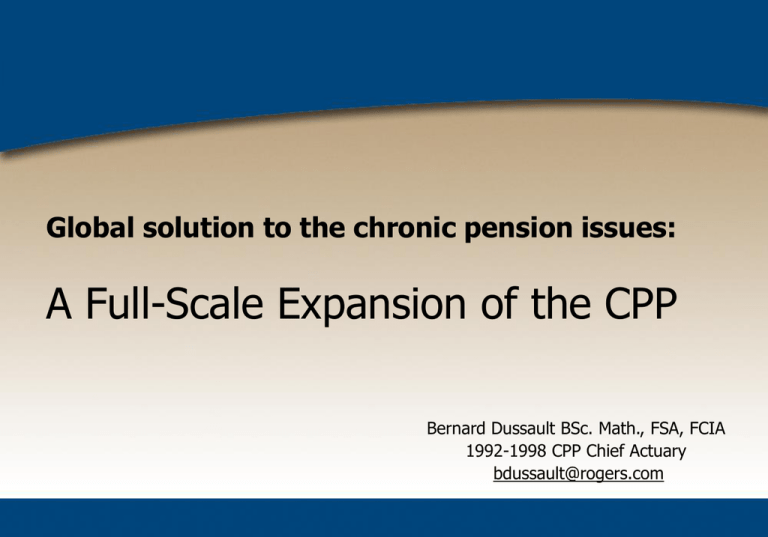To View Bernard Dussault`s full PowerPoint Presentation
advertisement

Global solution to the chronic pension issues: A Full-Scale Expansion of the CPP Bernard Dussault BSc. Math., FSA, FCIA 1992-1998 CPP Chief Actuary bdussault@rogers.com Acronyms CPP CPPIB DB DC GIS ITA OAS RPP RRIF RRSP YBE YMPE Canada Pension Plan CPP Investment Board Defined Benefit (pension plan) Defined Contribution (pension plan) Guaranteed Income Supplement Income Tax Act Old Age Security Registered Pension Plan Registered Retirement Income Fund Registered Retirement Savings Plan Year’s Basic Exemption (CPP) Year’s Maximum Pensionable Earnings (CPP) Pension landscape: main issues 1. Sustained failure of working Canadians to save enough for a proper level of income replacement during their retirement about 2/3 of workers and 1/3 of seniors are not covered by a RPP; about 1/3 of workers use only about 6% of their RRSP room, most of which is withdrawn before retirement 2. Chronic solvency problems affecting DB plans and recurring investments losses affecting DC plans and RRSPs 3. Current trend of conversion of DB plans into DC plans Pension landscape: main concern High level of seniors’ poverty • Statistics Canada: 4% • GIS average take-up rate: over 35% • GIS recipient’s total annual income: $14,000 to $19,000 Criteria of a proper solution to the chronic pension issues 1. National mandatory coverage under one or a series of universal pension plans 2. Defined Benefit vs. Defined Contribution plans 3. Covering all employment earnings (i.e. no basic exemption) Deficiencies of DC plans & RRSPs Retirement income security under DC plans & RRSPs 1. Yield on investments lower than with DB plans 2. Annuities: high cost 3. RRIFs: Amount and duration of income are not guaranteed 4. Income is not indexed to inflation 5. No defined survivor benefits Ideal solution to the pension crisis: a full-scale CPP expansion 1. 2. 3. 4. 5. 6. 7. 8. 9. CPP: a mandatory fully portable indexed DB plan Lower cost, shared equally by employers & employees Employer not involved in the administration of the plan No issues of coordination of DB plans with CPP No surplus ownership issues Accrued credits not affected by employer’s bankruptcy CPP provides defined disability and survivor benefits No marriage date-related restriction other than 12 months (eligibility to surviving spouse pensions) Gradual reduction of poverty among Canadian seniors (reduced reliance on GIS) The two dimensions of a full-scale CPP expansion A- $80,578 increase in the YMPE, i.e. – from $47,200 (YMPE for 2010) – to $127,778 (RPP-related ITA limit for 2010) B- 45% increase in the retirement benefit rate – from 25% (maximum annual pension: $11,210) – to 70% (maximum annual pension: $84,972) Expanded CPP Full-scale CPP expansion retirement pension % 70% 60% 50% Expanded CPP - 70% (benefit rate) - $127,778 (ITA limit) 40% 30% 20% Existing CPP 25% (benefit rate ) $47,200 (YMPE) 10% 0% 1 15 29 43 57 71 salary ($000) 85 99 113 Full-scale CPP expansion: extravagance? • About 30% of Canadian workers are already covered under a DB pension plan • An all-embracing CPP is much less expensive than a CPP/RPP combination (about 5% of salary for the federal public service plan) Cost estimate of the full-scale CPP expansion Existing CPP: 9.9% of salary from YBE to YMPE ADDITIONAL contribution rate (full-funding basis) for the CPP expansion: • 9.9% of salary up to YMPE (no YBE) (pursuant to the 25% to 70% benefit rate increase) (NB: coincidence with the existing CPP 9.9% rate) • 15.4% of salary from YMPE to ITA limit (pursuant to the 0% to 70% benefit rate increase) Expansion implemented in two steps • Increase in benefit rate 1st step: from 25% to 50% (of salary up to YMPE) from 0% to 50% (from YMPE to ITA limit) 2nd step: from 50% to 70% • Increase in contribution rate 1st step: 5.5% (up to YMPE), 11% (YMPE to LIR) 2nd step: 4.4% (up to ITA limit) spread over 5 years for each of the two steps Transition from RPPs (discontinued) to CPP expanded portion (new plan) EXISTING PENSIONS & ACCRUED BENEFITS WOULD NOT BE AFFECTED 1. Contributions – To RPPs and RRSPs: discontinued – All future pension contributions now go to CPP (full funding) 2. Pension accruals – Existing RPPs: discontinued – All new CPP pension credits accrue gradually over 47 years (even if the 45% benefit rate increase is immediate) 3. Commencement date of retirement pensions – RPPs: generally under age 65 – CPP: normally at age 65 Main issues of (& solutions thereto) a full-scale CPP expansion 1. Future accruals: normal age (65) of pension commencement is generally higher under the CPP. (A- Bridging benefit B- Consistent with increasing age at which workers entry & exit the labour force, and die) 2. Amount of CPP pension: possibly lower than under RPP (average vs. final salary: fair. CPP costs < than a typical RPP & provides disability benefits) 4. Huge fund (to be fragmented among provinces, CPPIB not involved) 5. All pension eggs in the same basket (fund fragmentation; most individual plans are anyway affected to quite same extent by market fluctuations) 6. Shrinking of the private pension business (a good portion of additional CPP contributions could be invested by financial institutions) 7. Increase in business costs for non RPP sponsors (global compensation: lower salary increases, consistent with increased savings) 8. Deferral of tax revenues of about $4 billion annually (net, accounting for effect of reduction in OAS & GIS benefits and in RRSP contributions) 9. CPP contributions are subject to 15% tax credit while GIS benefits are financed though progressive taxes. (reduced reliance on Robin Hood) What should be done in the meantime? • 14 June 2010 agreement in principle by the federalprovincial finance ministers for a modest CPP expansion • Contribution holidays under DB plans – Are the main reason for DB plans solvency problems – Should be fully prohibited, while emerging surpluses and deficits should be amortized over a uniform period of at least 5 years Prohibiting contribution holidays & amortizing surpluses and deficits • optimizes the stability of the RPP contribution rate • prevents major RPPs’ solvency problems • prevents at any time the RPP from becoming overly underfunded or overfunded (the amortization of emerging surpluses and deficits would normally prevent the pension fund to exceed at any time 25% of the RPP liabilities) • avoids the need to maintain any distinct earmarked contingency fund within or outside the pension fund • optimizes intergenerational equity among successive cohorts of contributors








